As an Amazon Associate I earn from qualifying purchases.
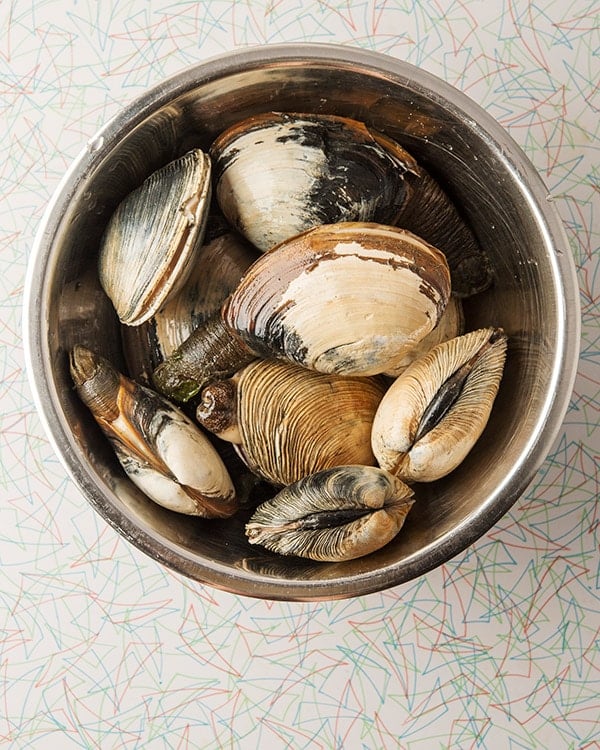
Clammers here on the Pacific Coast have heftier bivalves to contend with than the familiar quahogs, steamers and surf clams of the Atlantic.
We have an entire family of what are collectively called “gaper” clams, so called because there is so much clam to them their shells cannot fully close. The king of all these are the Pacific Northwest’s geoduck (and it’s New Zealand cousin the Panopea zelandica), but more common are the Washington clam (Saxidomus gigantea) and the horseneck clams, Tresus capax and T. nuttallii.
All can be, well, daunting when you wrangle them out of the mud and sand. They’re big, heavy, gooey… and there’s that well-endowed siphon of theirs, too. The very idea of eating one on the half shell makes me retch. And frying them is out of the question — at least whole. So what to do?
Here’s how to clean gaper clams to get them ready to eat, and at the end of this post I have a video I shot with my friends over at Original Fare on how to clean gaper clams that should cement in your mind these instructions.
First, you need to purge your clams. Read this article on how to do that.
When you are ready to do the cleaning, find a short, sharp knife like a paring knife or pocketknife. Get a big bowl to work over, because you want to capture all that wonderful clam juice. Be near a sink and running water.
Understand that a gaper’s shell is held tight by the same two “scallop” muscles all tasty bivalves use. You want to slip your knife into the shell above the siphon and run it along the inside of the top shell, slicing free the first “scallop” muscle and all the various bits. You can now open the shell completely.
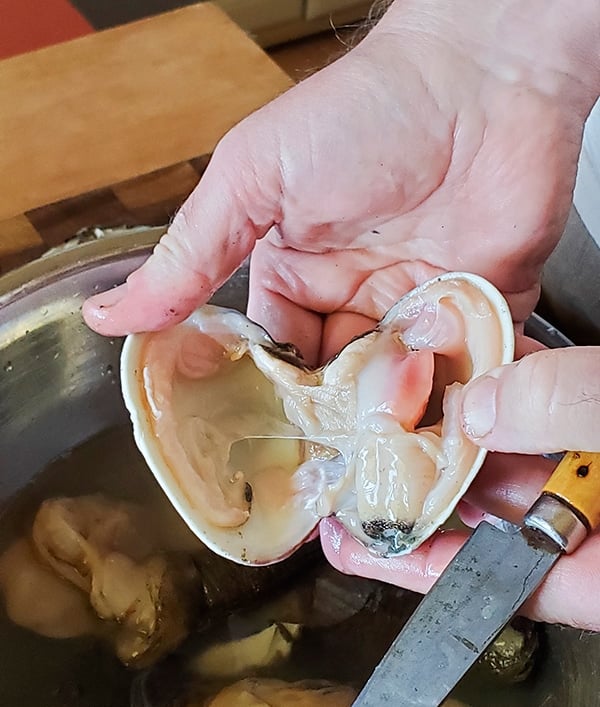
Yummy, eh? We’ll get to the anatomy of a clam in a bit. Now run your knife the same way, underneath the clam this time, to free it from the bottom shell. Drop it into the bowl with all the clam juice. Repeat until you have all the clams out of their shells. I discard the horseneck clam shells, but clean and keep the shells from large Washington clams; they make excellent dishes for stuffed clams.
With a bowl of gooey clam bits floating in salty clam juice staring at you, now what? First, remove all the horseneck (or geoduck) siphons from the rest of the clams. Cut just the siphon off, leaving the rest in one piece. Set the siphons aside. The siphons of Washington clams can be left on, as they don’t have the same gnarly skin on them.
Separate the clam juice from the clam meats. I do this by pouring the juice through a strainer that has a paper towel set inside it into another bowl. This is vital because whatever grit is left after purging will settle in the bottom of your bowl. Grit is the enemy. Keep this juice (it freezes well) for seafood soups and other recipes. I also freeze my clam meats submerged in the clam juice.
This is what the shucked clams look like. Washington clam on the left, horseneck on the right.
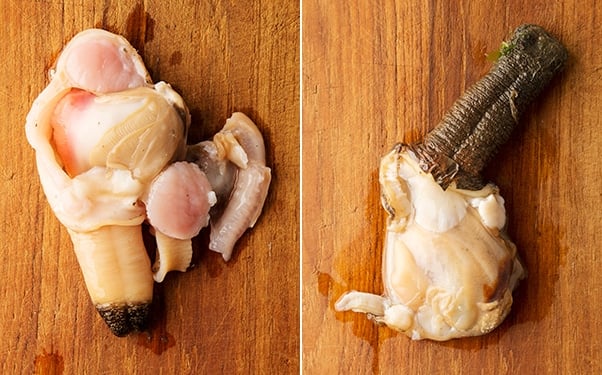
In general, you will want to keep the siphon, the two little “scallop” muscles, the dense, muscular foot, and the frilly, firm gills. You separate all this from the belly, and it will look like this.
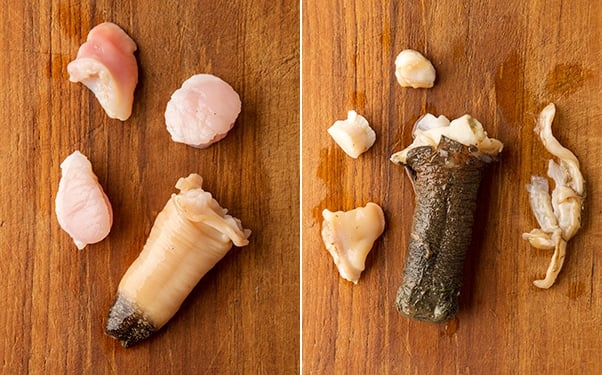
The last thing you must do with the clam meats is clean the bellies. Doing this is the nastiest part of cleaning clams, so nasty that some people discard the bellies altogether. I rarely do this.
To clean the bellies, find the muscular foot and look opposite to it: You will see a dark splotch on a soft, bag-like thing. Squeeze the belly to extrude the black ick from within the belly. When you do this, you will see a hideous, glasslike “pen” shoot out of the belly — it is alarming until you get used to it. Discard this. Run the opened belly under clean running water and use your fingernail to scrape out most of the black stuff.
Your clams are ready to chop or grind now. You can’t really eat gaper clams whole like littlenecks — they’re just too chewy. I grind mine for clam cakes or clam chowder, but many people chop them by hand. Either is fine.
As for the siphons, in the case of horseneck clams, you need to blanch them in boiling water. I boil for 30 to 60 seconds, then plunge the siphons into a bowl of ice water. Slice off the horny end of the siphon and discard. The skin should peel off pretty easily, revealing light colored clam meat with a pretty magenta tip.

You can chop or grind the siphons with the rest of the clam, or you can pound them thin between pieces of plastic wrap and slice for sushi or ceviche or stir fries. Keep in mind that all but the youngest of horse clams will have very tough meat, so don’t skip the pounding step unless you are able to slice it so thin it’s translucent.
Once cleaned, I keep my clam bits in the clam juice, which is salty and will help keep everything fresh. They’ll keep in the fridge for a couple days, but you should freeze them after that. When you freeze, leave at least 1 inch of head space in the jars because the water will expand when it freezes. Frozen like this, the clams will keep a year.
Got it? Great! Now watch this video of me cleaning clams. It should firm up everything for you.
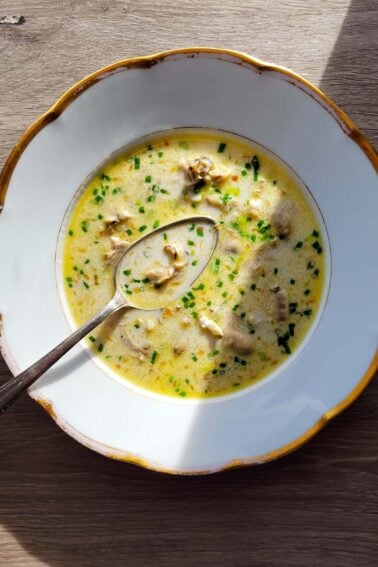

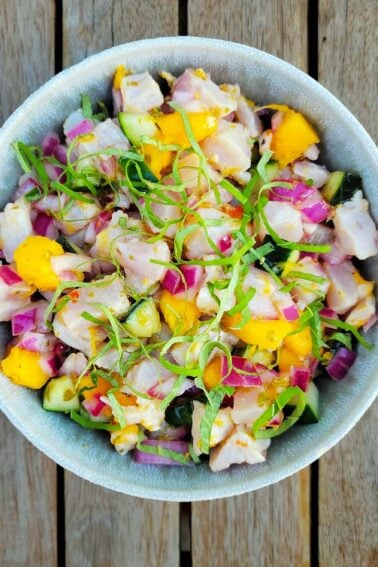
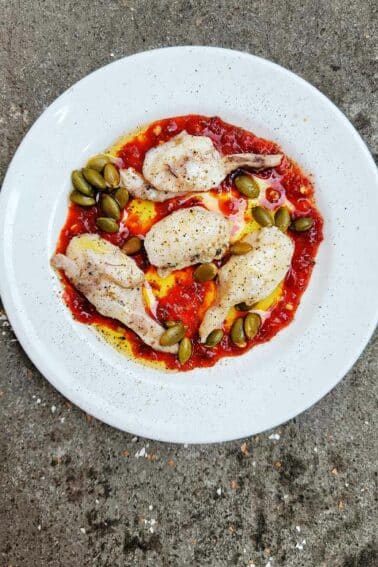
Any recipes on how to make Clam Juice from horsenecks? I just got my first bunch of horsenecks from Bodega Bay this morning, and my wife REALLY wants me to make Clam Chowder. My problem is she will only eat what I catch. Literally. Your recipe calls for 1 quart of Clam Juice, which maybe I can make stock from the thrown out parts of the horsenecks???
Darren: There is no recipe. Clean your clams over a bowl. That’s the juice. Filter it through a paper towel and you have clam juice.
Hey Hank,
how do you think smoking these would turn out… mainly for making a smoked clam dip?!…or do you think there is another larger clam out there that could smoke like a manilla or butter clam ?
cheers,
B
Smoked clams are delicious ?
We always clean our clams then vacuum seal them. They tend to keep for about 1 year. We clam in Oregon, the gapers there have crabs in them.
Hank Great article. We don’t clean the stomach as we found out the stomach meat has high plastic particulate count in it. (anyway in our area) I’d advise checking w a shellfish bio in your area if that is true or not. As for the skin on the necks. We put them on parchment paper lined baking sheet and put them in the freezer for a few hours and then take them out and let them thaw out a little bit. The blackish/brown outer skin peels right off super easy without having to dunk them in boiling water. Another trick is to use coarse sea salt to rub the purple coloring out of them. We fry them like a razor clam only we use a meat hammer to soften the chew quit a bit.
Do you ever can your clam meat? We can razor clam necks for chowder and they become very tender. I would love to do this with the gaper clams.
Patti: I never have, but the standard protocol for fish and seafood is 110-120 minutes at 10 psi.
Should you clean the clams before freezing, I heard if you just freeze them after taking from shell, the flavor will sustain. do you know if this is true?
We are wanting to freeze for later date. We have shelled just wondering if we should do the rest of the cleaning or freeze wholel and clean when we are ready to enjoy?
Debbie: I always freeze clams submerged in their own juices that I’ve strained all the debris from. Works great.
The “hideous glasslike” thing that resembles a large pin is common to many shellfish, and is actually a good indicator that the shellfish are fresh. It’s an enzyme produced and is harmless and doesn’t affect the taste of what you’re eating. Nothing to fear, and something you should hope to see!
Andrew: Thanks! Still gnarly, though. 😉
Perfect timing for this post – I just dug up 4 horse clams and my first geoduck today!
BTW, the glasslike pen thing is called the crystalline style:
https://wdfw.wa.gov/fishing/shellfish/razorclams/clean_prepare.html
Rather than blanching the necks try this… Cut them off, submerge in a bowl of freshwater in the frig overnight and voila by morning the skin will peel right off. Easy and quick. Try it, it works great
Mike Malone
Mike: Cool! Thanks for the tip.
Hey, I think that one on the right side of the bowl looks familiar! Good clamming with you, Hank. Glad you made something of the bunch for the site.
Hi Hank,
Loved the video! I find it so uplifting that you are doing basically what I’ve been doing with giant quahogs for the last 25 years. Delmarva natives scoff at me for cleaning out the guts (which DO have that pin thingie, sometimes more than one), but I like my clam meat for chowder WHITE and partially digested black sand dirt stuff isn’t all that wonderful. So….rock on, cat Daddy!
Nicky
Fabulous video on cleaning gaper clams!
Even more fun when there’s a parasitic Pea Crab inside! First time I saw one it erupted out of the clam I had begun to clean like something from Alien. Much yelling and general heebie jeebies. https://en.wikipedia.org/wiki/Pea_crab But they’re big, relatively tasty when ground or chopped, or people around here use them for crab bait.